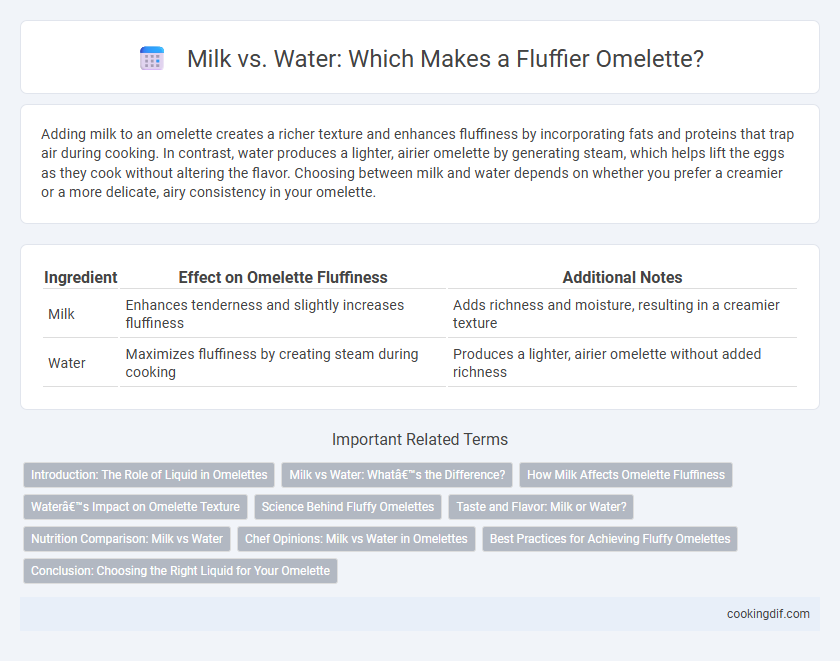Adding milk to an omelette creates a richer texture and enhances fluffiness by incorporating fats and proteins that trap air during cooking. In contrast, water produces a lighter, airier omelette by generating steam, which helps lift the eggs as they cook without altering the flavor. Choosing between milk and water depends on whether you prefer a creamier or a more delicate, airy consistency in your omelette.
Table of Comparison
| Ingredient | Effect on Omelette Fluffiness | Additional Notes |
|---|---|---|
| Milk | Enhances tenderness and slightly increases fluffiness | Adds richness and moisture, resulting in a creamier texture |
| Water | Maximizes fluffiness by creating steam during cooking | Produces a lighter, airier omelette without added richness |
Introduction: The Role of Liquid in Omelettes
The choice between milk and water significantly influences an omelette's texture and fluffiness, as the liquid adds moisture and affects the egg proteins' coagulation during cooking. Milk contributes fat and proteins that create a richer, creamier texture, while water introduces steam, promoting a lighter, airier omelette. Understanding the impact of these liquids helps in mastering the balance between tenderness and fluffiness in omelette preparation.
Milk vs Water: What’s the Difference?
Using milk in an omelette adds richness and enhances fluffiness by increasing moisture and protein content, which helps create a tender texture. Water, on the other hand, steams the eggs during cooking, resulting in a lighter, airier omelette with fewer calories. The choice between milk and water ultimately influences the omelette's texture and taste, with milk offering creaminess and water producing a more delicate fluffiness.
How Milk Affects Omelette Fluffiness
Milk increases omelette fluffiness by adding moisture and fat, which help soften the eggs while creating a tender texture. The proteins in milk also trap air bubbles during cooking, leading to a lighter, more voluminous omelette. Using milk instead of water enhances the creaminess and overall mouthfeel.
Water’s Impact on Omelette Texture
Water enhances omelette fluffiness by creating steam during cooking, which helps lift and expand the egg mixture for a lighter texture. Unlike milk, which adds creaminess and density, water keeps the omelette airy and soft without weighing it down. This steam-induced fluffiness results in a tender omelette with a delicate crumb structure that is highly desirable for a perfect breakfast dish.
Science Behind Fluffy Omelettes
In creating fluffy omelettes, milk and water play distinct roles due to their molecular properties influencing protein coagulation. Milk's fat and sugar content tenderize the eggs and create a richer texture, while water generates steam during cooking, expanding the egg mixture for increased volume and lightness. Scientific studies show that water incorporation yields a visibly puffier omelette by enhancing steam production, though milk enriches flavor and softens texture.
Taste and Flavor: Milk or Water?
Milk enhances the creaminess and richness of an omelette, imparting a subtle sweetness that elevates its flavor profile. Water, by contrast, creates a lighter, airier texture without altering the taste, allowing the natural egg flavor to shine. For a more indulgent and flavorful omelette, milk is preferred, while water suits those seeking a delicate and mildly textured dish.
Nutrition Comparison: Milk vs Water
Milk enhances omelette fluffiness by adding protein and fat, which contribute to a richer texture and improved nutrient density, including calcium, vitamin D, and B vitamins. Water creates steam, making the omelette lighter and airier but lacks the nutritional benefits found in milk. Choosing milk over water increases caloric content and essential nutrients, supporting stronger bones and overall health while still maintaining omelette fluffiness.
Chef Opinions: Milk vs Water in Omelettes
Chefs often debate using milk versus water for omelette fluffiness, with many favoring water as it creates steam during cooking, helping the eggs puff up more. Milk adds creaminess and richness but can weigh down the omelette, resulting in a denser texture. Culinary experts emphasize that water enhances lightness and airiness, making the omelette fluffier compared to the creamier, slightly heavier finish from milk.
Best Practices for Achieving Fluffy Omelettes
Using milk in omelette batter enhances fluffiness by adding moisture and fat, which helps create a tender texture. Water vaporizes during cooking, generating steam that puffs up the omelette for a lighter, airier result. Best practices include whisking eggs thoroughly with a small amount of either milk or water and cooking over medium-low heat to maintain even rising and prevent over-drying.
Conclusion: Choosing the Right Liquid for Your Omelette
Milk enriches omelettes with creaminess and a tender texture due to its fat and protein content, creating a fluffier and richer result. Water, by adding steam during cooking, helps achieve a lighter, airier omelette without altering the flavor but produces less creamy texture. For maximum fluffiness with a balance of richness, using milk is often preferred, while water suits those seeking a lighter, more delicate finish.
Milk vs Water for fluffiness Infographic

 cookingdif.com
cookingdif.com